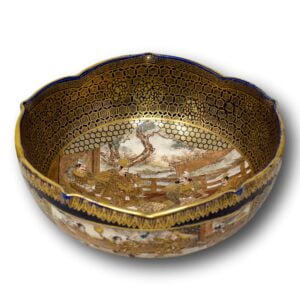Description
Signed to the Base 長州山造 Choshuzan
From our Japanese Satsuma Collection, we are delighted to offer this Japanese Quatrefoil Satsuma Vase by Choshuzan. The Satsuma vase of beautiful quatrefoil globular shape with rolled neck and spread foot is decorated with four large interlocked scenes potted from earthenware. The scenes each depicting large mountainous landscapes with trees and water, two of the panels feature multiple figures and one with a temple setting. The panels are decorated with beautiful blossoming flower borders and geometric lines to both the top and bottom. The Japanese Satsuma Vase by Choshuzan is signed to the base in gold on a black ground 長州山造 translated as Choshuzan (Choshu) made and dates to the Japanese Meiji period (1868-1912).
Choshuzan (Choshu)
Choshuzan pottery / workshop was active in Kyoto late Meiji period. Choshuzan is often found on “dragon ware”, and often with additions such as “respectfully made” or together with the decoration painter.
MEIJI PERIOD (1868-1912)
The Meiji era marked Japan’s transformation into a modern nation and a golden age of decorative arts. With the end of samurai rule and Japan’s opening to the West, artisans produced works of exceptional quality for both domestic and international audiences. Supported by the government through world fairs and Imperial commissions, Japanese lacquerware, cloisonné, satsuma ceramics, bronzes, and ivory carvings reached collectors worldwide. Many leading artists of the time, including Makuzu Kozan and Namikawa Yasuyuki, were honoured as Imperial Household Artists, ensuring the Meiji period remains one of the most celebrated eras of Japanese art.
For further information please see our article Japanese Meiji Period: Art, Collecting, and Cultural Transformation.
SATSUMA WARE
Satsuma ware originated in southern Kyūshū around 1600 and developed into one of Japan’s most recognisable ceramics. Early Ko-Satsuma pieces were rustic, dark-clay wares made for everyday use, while the later Kyō-Satsuma style became famous worldwide during the Meiji period.
Characterised by ivory crackled glaze, delicate overglaze enamels, and lavish gilding, export Satsuma appealed strongly to Western collectors. Designs often feature landscapes, flowers, figures, and scenes from Japanese life and mythology. Renowned artists such as Yabu Meizan, Ryozan, and the Kinkōzan workshop produced some of the finest examples, which remain highly sought after today. Genuine Satsuma can often be identified by the Shimazu crest, artist signatures, or the mark “Dai Nippon” used during the Meiji era.
For further information on the history of Satsuma Wear please see our article Japanese Satsuma Ware.
MEASUREMENTS
20cm High x 19.5cm Diameter (7.9 x 7.7 Inches)
CONDITION
Very Good – some minor rubbing in places
With every purchase from Jacksons Antique, you will receive our latest product guides, certificate of authenticity, full tracking information so you can monitor your shipment from start to finish and our personal no-hassle, money-back policy giving you that extra confidence when purchasing. Don’t forget to sign up to our newsletter to receive 10% off your first online purchase with us!


































